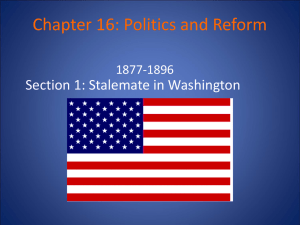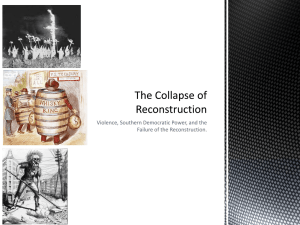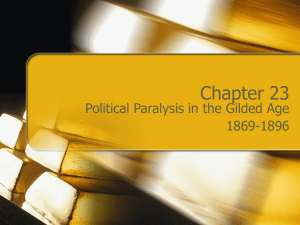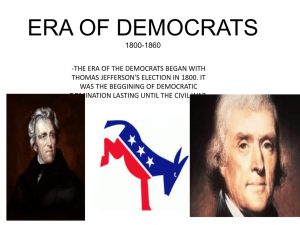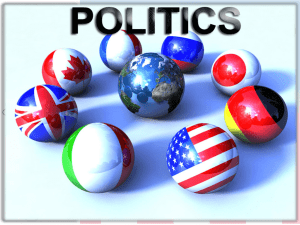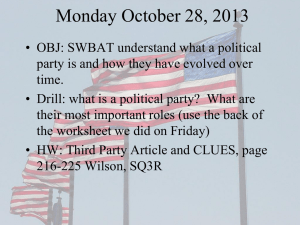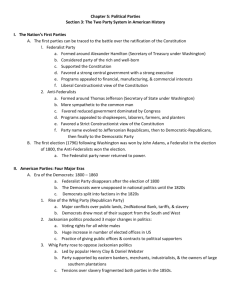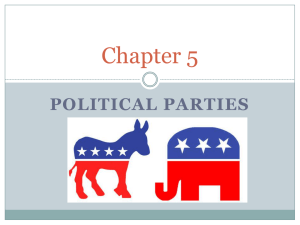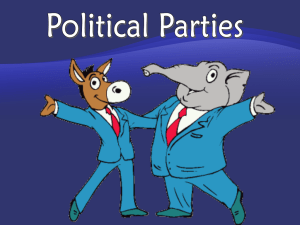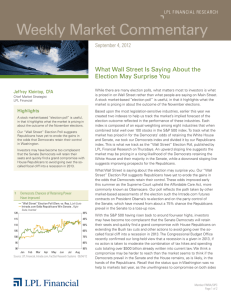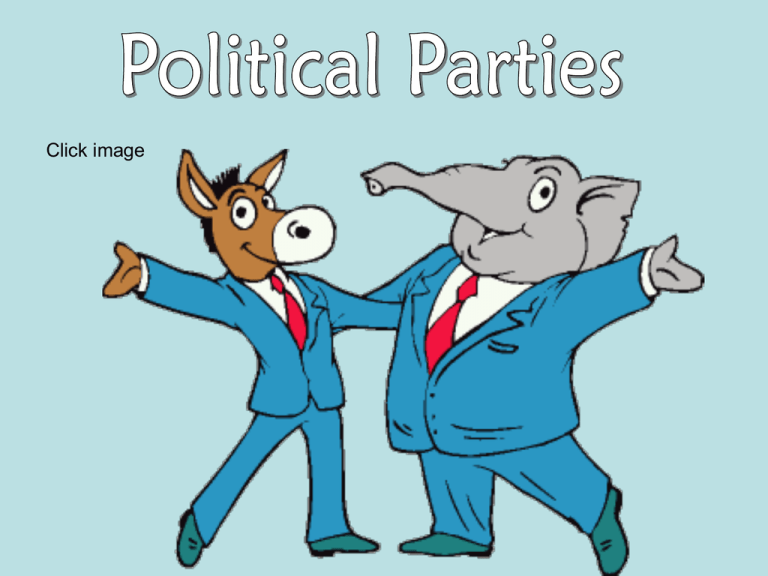
Click image
DEMOCRATS
REPUBLICANS
•
•
•
*Pro choice
*less support of the war
*support stem cell research
•
*pro environment
*Pro Life
*more support of the war
*not as supportive of stem cell
research
*less regulation of pollution
•
*supportive of civil rights of all people *supportive of civil rights for
citizens
*Gun control
*Pro 2nd amendment
*less supportive vouchers/private schools
*Pro vouchers
*against the death penalty
*Pro death penalty
*against prayer in school
*for religion in school
*for discussing sex education
*for promoting sexual
abstinence
*open to civil unions
*against civil unions
*for the tax system as it exists
*for revising the tax systems
*for social security
*against social security
*for social programs
* not as much for social
programs--welfare, arts ,etc
*for big government
*more for state’s rights
•
•
•
•
•
•
•
•
•
•
Party Coalitions Today
Section 1: Parties and What They Do
A Political Party isA group of people who look to control the
government and WIN ELECTIONS!
The Two major Political Parties in America are the1. Democrats
&
2. Republicans
A more SPECIFIC definition of political partiesA group of persons, joined together on the basis of
common principles, who seek to control government
in order to affect certain public policies and
programs.
WHAT DO PARTIES DO?
Parties are the major mechanisms behind the development of
broad policy and leadership choices.
They are a VITAL Link between the people and their government.
They are the principal means by which the will of the people is
made known to government and by which government is held
accountable to the people.
Parties are also the “Power Brokers” they try to bring conflicting
groups together.
They modify and encourage Compromise among the contending
views of different issues and groups. They soften the impact of
extremes at both ends of the political spectrum.
Political Parties Major Function is to nominate candidates for
political office.
*****Then the parties work to help that candidate WIN elections.
Informing and Activating Supporters
Parties inform the people and inspire and activate their interest
and participation in public affairs. They inform and inspire by
1. taking stands on the issues
2. campaigning for candidates
3. criticize opposing candidates positions
Each party tries to put their party in the best possible light.
How much money does it take
to win an election?
Presidential
• http://www.opensecrets.org/pres12/in
dex.php
2012 election priciest to date: $4.2 billion
tab and rising
By Jennifer Liberto @CNNMoney November 5, 2012: 6:36 PM ET
113th Congress
2013-2014
HOUSE—
Republicans control
SENATEDemocrats control
Membership
•435 Members
Membership
•100 Senators
(Vice President votes in
case of a tie)
Party Divisions
200 Democrats
233 Republicans
0 Independents
2 Vacancies
Party Divisions
•53 Democrats
•45 Republicans
•2 Independents
http://clerk.house.gov/member_info/cong.aspx
113th Congress by the Numbers
Chart
http://en.wikipedia.org/w
iki/113th_United_Stat
es_Congress
They conduct the educational process through:
1. pamphlets
2. signs
3. buttons
4. stickers
5. newspaper ads
6. magazine ads
7. radio ads
8. television ads
Remember both parties want to WIN Elections and attract as
many voters as possible!
They try to offend as few voters as possible. That is why they
are so VAGUE!!!!!
The Bonding Agent Function
When choosing candidates they want to make sure that
men and women are:
1. both qualified
and
2. of good character
GOVERNING
Government in the United States is government by PARTY.
The government conducts much of its business on the basis of
PARTISANSHIP.
Define Partisanship:
The strong support of the party and its policies
Political Parties were NOT MENTIONED in the Constitution!
However, they have played a significant role in the process of Constitutional
Change!
• ACTING AS A WATCHDOG
• The party out of power acts as a
“WATCHDOG”. They Criticize the
policies and behavior of the Party in
Power.
• They try to convince the public to
“throw the rascals out”.
They act as the “loyal opposition.”
# of House
Seats
Democrats
Republicans
105th
(1997-1999)
435
206
228
106th
(1999-2001)
435
211
107th
(2001-2003)
435
108th
(2003-2005)
Congress (Years)
Other
Vac.
Del./Res.
Independent (1)
0
4/1
223
Independent (1)
0
4/1
212
221
Independents (2)
0
4/1
435
205
229
Independent (1)
0
4/1
109th
(2005-2007)
435
202
232
Independent (1)
0
4/1
110th
(2007-2009)
435
233
202
Independent (0)
0
4/1
111th
(2009-2011)
435
257
178
Independent (0)
0
5/1
112th
(2011-2013)
435
193
242
Independent (0)
0
5/1
Election Laws Lock Out Third Parties
Click image below
Chapter 5 section 2: The Two Party System 2007 Text
Why a two party system? TRADITION
****Political Parties were not written into the Constitution
First 2 Parties were led by
FEDERALISTS
Alexander Hamilton
ANTI-FEDERALISTS
Thomas Jefferson
George Washington warned of
“the baneful effects of the spirit of party”
THE FORCE OF TRADITION
Once established, human institutions are likely to become
self-perpetuating (Old Habits Die Hard!)
Most Americans accept the idea of a two party system
because there has always been one.
THE ELECTORAL SYSTEM
Single member districts--- only ONE candidate wins an
election through the “winner take all” system
You don’t need a majority, just a plurality!
Plurality = the most votes
Voters usually face only two viable candidates.
Most voters think a vote for a minor party candidate is
a “wasted vote”. Therefore Minor parties do not have wide
voter support.
Plus most of American Election Law is PURPOSELY WRITTEN
to discourage non-major party candidates!
The 2 major parties work in a bipartisan ( together ) way when it
comes to election laws and keeping third parties out of elections!
In presidential Elections there have only been 7 presidential
elections where a minor party candidate was able to get their
name on all 50 state’s ballots!
Eugene V. Debs was the first to accomplish this in 1912.
Most recently in 1996--- Ross Perot
THE AMERICAN IDEOLOGICAL CONSENSUS
American people have many of the same shared ideals,
principles and patterns of belief.
Even though we are a pluralistic (diverse) society.
There is broad Consensus (agreement) on fundamental
matters.
Still, the nation is plagued by sharp and unbridgeable political
divisions.
Both of the two major parties tend to be MODERATE!
They have to in order to win over the most votes from the
electorate.
MULTIPARTY SYSTEMS
Could America become a multiparty system where we
have several major and many lesser parties?
Most European Democracies have this system.
Multiparty systems tend to produce broader more diverse
representation of the electorate (voters).
However they also tend to lead to instability in
government.
Italy is a prime example of this multiparty system that
leads to instability within the government.
ONE PARTY SYSTEM
Really means a NO PARTY system because you have no
choices in an Election!
The Soviet Union’s leader Stalin is a prime example of this.
PARTY MEMBERSHIP PATTERNS
Membership is purely VOLUNTARY!!!
Democrats— tend to be more women, minorities,
Jews and union members
Republicans --- tend to be more WASP & , Christian males
Your FAMILY is probably the biggest influence on what party
you belong to.
The Two-Party System in American History—
Chapter 5 section 3 notes
The Nation’s first parties came out of the
ratification process of the Constitution.
Click the image below
1. FEDERALIST Party
Led by Alexander Hamilton
“the rich and the well born”
supported the Constitution
w/out a Bill of Rights
2. ANTI-FEDERALIST Party
“Democratic-Republicans”
Led by Thomas Jefferson
“Common Man”
wanted the Bill of Rights in the
original Constitution
Wanted a Strong National Government Wanted a Limited Role for the
National Government
more State’s Rights
Believed in a Liberal interpretation
of the Constitution
Believed in a Strict interpretation
of the Constitution
ELECTION of 1800---
Adams, the incumbent loses to ---------JEFFERSON
Federalists die out
ELECTION of 1828--- DEMOCRATIC PARTY
A. Jackson leads
FOUR Major Eras of American Political Parties
Era of the Democrats, 1800-1860
Most support from the South & West
Got voting rights for all white males
Increased the number of elected offices
Spread the Spoils System
Whig Party- 1830’s -1850’s
Eastern Bankers, merchants, industrialists
and southern plantation owners
supported high tariffs
1850’s will lead to division over
slavery issue
REPUBLICANS ERA
1860-1932
Democrats are crippled by
the Civil War
many Whigs become members
“Solid South” is the
against slavery
only reason they hold on
President Lincoln
is their first president
supported by business, farmers,
laborers and newly freed slaves
1912 election--- the DIVIDE
TAFT vs.
T. Roosevelt
the Bull
Moose Partyand
Woodrow Wilson (D)
The Return of the Democrats
1932-1968
FDR—elected to four terms!
Truman- finishes FDR’s 4th term
and is elected to 1 term
Eisenhower- 2 terms (R)
JFK- 1 term but is assassinated
Johnson- finishes JFK’s term
but is elected to his own term
THE START OF A NEW ERA
“Divided Government”
Republicans
Democrats
1968-Nixon
elected to 2 terms but resigns in 2nd term
Ford- finishes Nixon’s 2nd term
Carter- 1 term
Reagan-2 terms
George H. W. Bush- 1 term
Clinton- 2 terms
George W. Bush- 2 terms
Barrack Obama
The MINOR PARTIES
Chapter 5 section 4
4 types of Minor parties
1. Ideological--- those based on a particular set of beliefs
Libertarian, Communist, Socialist
2. Single Issue ------ focus on one public policy matter
“Know nothings” ( opposed Irish Catholic immigrants)
Prohibition—against the making and selling of alcohol
Green Party--- started out for the Environment
now has more issues
Right to Life--- against abortion
3. Economic Protest----
rooted in periods of economic discontent
Populist Party- wanted public ownership
of utilities, lower tariffs
Tea Party---today???
4. Splinter Parties—those that split from Major Parties
Bull Moose Party and T. Roosevelt
Progressive Party of 1924
Progressive Party of 1948 (Democrats)
G. Wallace and the American Independent Party 1968
(anti civil rights-Democrat)
Ross Perot and the Reform Party- 1992 election
WHY ARE MINOR PARTIES IMPORTANT?
--- their ideas get copied by the two major parties
Anti-Masons ---- the National Convention
Populists---- direct election of senators, recall, initiative,
referendum, women’s suffrage,
Progressive income tax,
railroad regulation
They can play the “Spoiler Role” in elections
(T. Roosevelt & Ross Perot)
Libertarian Party— Legalization of marijuana?????
They are the critic and innovator!!!
Chapter 5—POLITICAL PARTIES section 5- Party Organization
The Decentralized Nature of the parties—no chain of command running
from the National to the local party
National Political Party, State Political Party, County Political Party,
Local Political Parties
The Role of the Presidency—
President is the automatic party leader of his party
Federalism creates a DECENTRALIZED government system---Federal & State
The Nominating Process sometimes leads to fights among party members—
2008 Presidential Primary—Hillary Clinton vs. Barack Obama
The National Party Machinery--National Convention---occurs once every four years in the year of the
Presidential election
National Chairperson—helps to create the National Convention
Congressional Campaign Committees—collect $ to re-elect incumbents
Incumbents--(members already in office)
STATE & Local Party Machinery--- same goals as National parties but on
a smaller level
The 3 components of the Party
• Party organization—party leaders and those who give their time & money
•Party Electorate- those members who usually vote for their party
•Party in Government—party officeholders who have political positions
The Future of Major Parties—
•A growing number of independents and a reduction of
Democrats and Republicans
•Increase in SPLIT TICKET voting—voting for some Democrats
and some Republicans
•Technology has changed campaigning and now the candidates
rely less on the party
•Growth of Single Issue organizations


